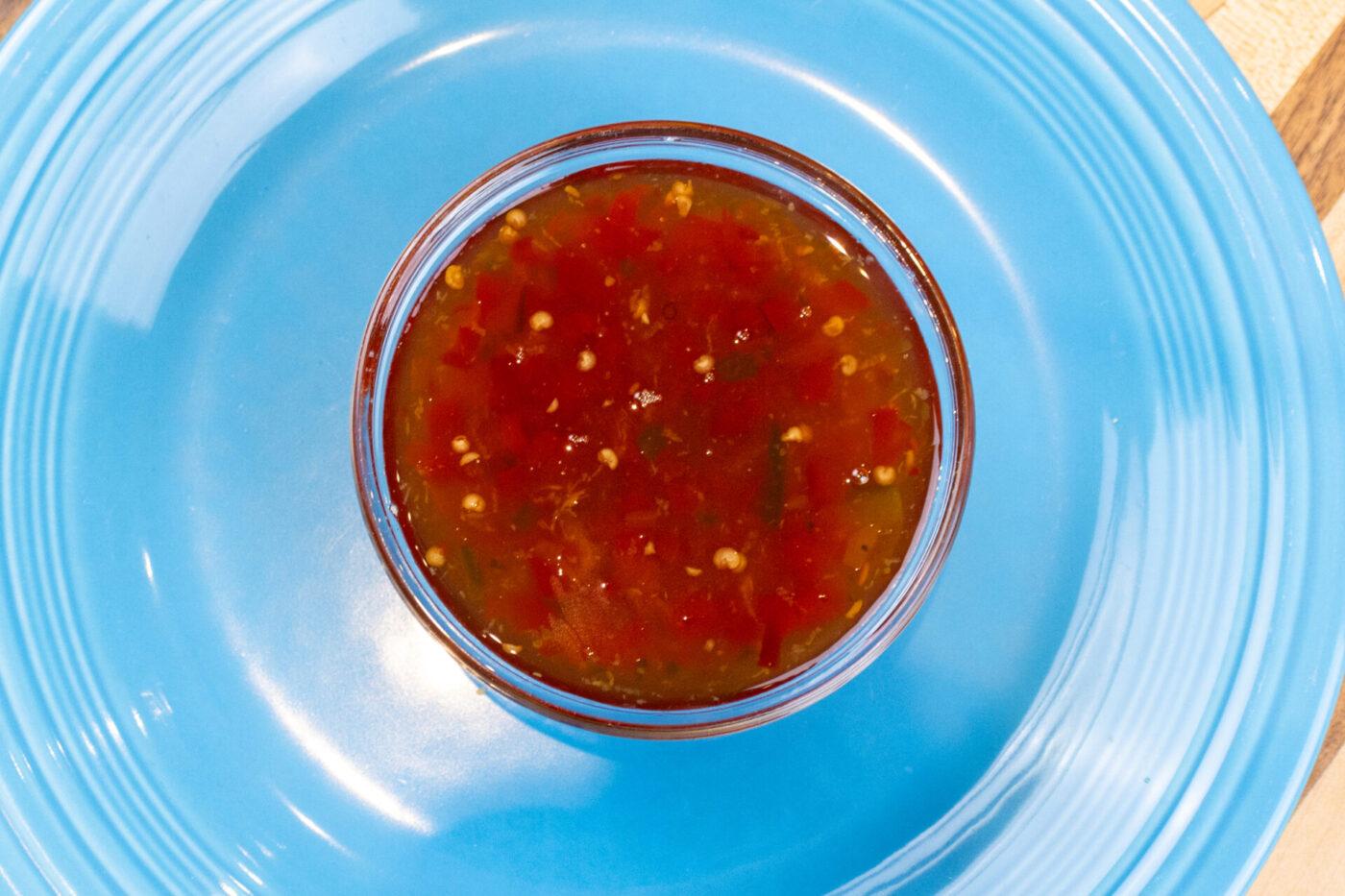Read More: History of Sweet Chili Sauce
The Thai Roots: A Dipping Sauce for Chicken and Beyond
The heart of sweet chili sauce’s history lies in Thailand, where it’s known as “nam chim kai” (น้ำจิ้มไก่). This Thai name translates literally to “dipping sauce for chicken,” hinting at its traditional purpose. In Thailand, nam chim kai is a ubiquitous condiment, often served alongside grilled or fried chicken, spring rolls, fish cakes, and other appetizers.
The precise origins of nam chim kai are somewhat murky, lost in the annals of time and the undocumented evolution of home cooking. However, it’s safe to say that the sauce developed organically within Thai culinary traditions, likely evolving over generations as cooks experimented with different combinations of local ingredients to create a flavorful accompaniment for their dishes.
Core Ingredients and Flavor Profile: A Balancing Act
Traditional Thai sweet chili sauce is characterized by its harmonious blend of four key flavors:
- Sweetness: Typically derived from palm sugar, granulated sugar, or sometimes honey.
- Spiciness: Provided by fresh or dried red chilies, with the type and quantity determining the heat level.
- Tanginess: Usually achieved with rice vinegar or sometimes lime juice, adding a refreshing acidity that cuts through the sweetness.
- Garlic: A crucial aromatic component, contributing a pungent depth and savory note that rounds out the flavor profile.
Unlike some other Southeast Asian chili sauces, authentic Thai nam chim kai is generally not fermented. The emphasis is on fresh, vibrant flavors, with the sweetness and heat balanced by the tangy vinegar and pungent garlic.
Regional Variations and Adaptations Within Thailand
Within Thailand, variations of nam chim kai exist, reflecting regional preferences and the availability of local ingredients. Some versions might include shallots, ginger, or fish sauce, adding further layers of complexity. The consistency can also vary, from thin and watery to slightly thicker and syrupy. However, the core balance of sweet, spicy, tangy, and garlicky remains the defining characteristic.
The Journey West: From Thai Specialty to Global Condiment
The global spread of sweet chili sauce is closely tied to the increasing popularity of Thai cuisine worldwide. As Thai restaurants began to proliferate in Western countries during the latter half of the 20th century, so too did the exposure to and appreciation for Thai flavors, including nam chim kai.
Several factors contributed to the sauce’s successful transition from a niche ethnic condiment to a mainstream staple:
- Universally Appealing Flavor Profile: The sweet, spicy, and tangy combination proved to be a winning formula, appealing to a wide range of palates, even those not accustomed to spicy food.
- Versatility: Sweet chili sauce proved to be incredibly versatile, complementing not only Thai dishes but also a wide array of Western appetizers, snacks, and even main courses.
- Commercialization: Food companies recognized the potential of sweet chili sauce and began producing bottled versions, making it readily available to consumers worldwide.
Commercialization and the Rise of “Thai Sweet Chili Sauce”
The commercialization of sweet brought about some changes to the traditional recipe. To extend shelf life and cater to Western tastes, manufacturers often:
- Increased the Sugar Content: Many commercial versions are significantly sweeter than traditional nam chim kai.
- Used Corn Syrup or Other Sweeteners: To reduce costs, some brands substitute cheaper sweeteners like high fructose corn syrup for traditional sugars.
- Added Thickeners: Cornstarch or other thickeners are often used to create a more viscous, commercially appealing consistency.
- Included Preservatives: Additives like sodium benzoate are commonly used to prolong shelf life.
- Reduced the Spice Level: To appeal to a broader audience, many commercial versions are relatively mild compared to authentic nam chim kai.
Despite these modifications, the core essence of sweet chili sauce – the balance of sweet, spicy, and tangy – remained, and it quickly gained popularity as a dipping sauce, marinade, glaze, and general-purpose condiment.
Beyond Thai Cuisine: A Global Culinary Citizen
Today, sweet chili sauce has transcended its Thai origins to become a truly global culinary citizen. It’s a staple in supermarkets, restaurants, and home kitchens worldwide, used in a myriad of ways:
- Dipping Sauce: For spring rolls, dumplings, chicken nuggets, fries, and countless other appetizers.
- Glaze: For grilled or roasted meats, seafood, and vegetables.
- Stir-Fry Sauce: Adding a sweet and spicy kick to stir-fried dishes.
- Marinade: Tenderizing and flavoring meats before cooking.
- Sandwich Spread: Adding a zesty twist to sandwiches and wraps.
- Salad Dressing Component: Providing a unique flavor dimension to salads.
A Continuing Evolution: New Flavors and Innovations
The story of sweet chili sauce is far from over. As its popularity continues to soar, new variations and innovations are constantly emerging. We see flavors infused with ginger, lemongrass, lime, and even fruits like mango or pineapple. There are versions with varying heat levels, from mild and approachable to fiery and intense. There are even organic and “all-natural” versions catering to health-conscious consumers.
Conclusion: A Testament to Flavor and Adaptability
The journey of sweet chili sauce from its roots in Thai home cooking to its status as a global condiment is a testament to the power of flavor and the adaptability of culinary traditions. It demonstrates how a simple yet perfectly balanced combination of ingredients can transcend cultural boundaries and capture the hearts (and taste buds) of people worldwide. As we continue to explore and embrace diverse culinary experiences, sweet chili sauce stands as a delicious example of how food can connect us, bridging cultures and creating new traditions one sweet, spicy, and tangy bite at a time. Its story is a reminder that the most successful culinary creations are often those that are both deeply rooted in tradition and open to innovation, evolving alongside the ever-changing tastes of the world.


Comments